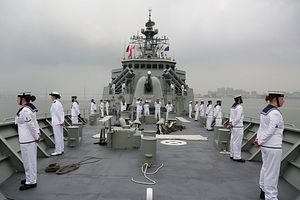Australia’s defense budget is set to increase by approximately 6 percent in real terms in fiscal year 2017-18, rising to A$34.7 billion (US$25.6 billion), according to recently release government figures. Actual spending in 2017-18 is expected to amount to A$32.5 billion, or around A$2 billion lower than the allocated budget.
The defense budget is slated to grow to two percent of GDP by 2020-21. “The 2017 budget maintains the government‘s commitment to provide Defense with a stable and sustainable funding growth path,” Australia’s Minister for Defense Marise Payne said in a statement. Australia’s defense spending is expected to increase by over 80 percent — from A$32.4 billion in fiscal year 2016-17 to A$58.7 billion in 2025-26 — over the next decade.
Spending projections for the next four years show that Australia’s military is slated to receive over A$150 billion in funding by 2020-21. Australia’s defense spending is decoupled from GDP growth. “This de-coupling from GDP forecasts will avoid the need to have to regularly adjust Defense’s force structure plans in response to fluctuations in Australia’s GDP,” the 2016 Defense White Paper notes.
Australia will spend approximately A$200 billion over the next ten years under the Integrated Investment Program on new military hardware, with A$89 billion allocated for the Royal Australian Navy’s (RAN) shipbuilding program alone. Among other things, the RAN will acquire three Hobart-class Air Warfare Destroyers, nine new future frigates optimized for anti-submarine warfare, 12 new offshore patrol vessels, and 21 patrol boats.
According to Payne, the Australian government has committed around A$12.2 billion to new defense capabilities since February 2016, including:
- Approval to commence design of the 12 future submarines, to be built in Australia.
- An investment of up to A$2 billion for the Short Range Ground Based Air Defense System, which will provide the inner-most layer of Australia’s enhanced integrated air and missile capability.
- An A$500 million investment in Australia’s Electronic Warfare Support Operations to boost testing equipment, tools, and laboratories to further strengthen the Australia Defense Force’s electronic warfare capabilities.
In December 2016, Australia and France signed an intergovernmental agreement for the development and construction of 12 Shortfin Barracuda Block 1A submarines, a diesel-electric derivative of French shipbuilder Direction des Constructions Navales Services’ (DCNS) Barracuda-class nuclear attack submarine, under the Royal Australian Navy’s SEA 1000 Future Submarine Program.
Total cost for the acquisition of the 12 boats is estimated at A$50 billion (US$38.13 billion).
In April, Australia selected U.S. defense contractor Raytheon to develop a new short-range ground-based air defense system for the Australian Army. “The defense deal — approximately worth US$1.5 billion — is the first step in the development of the army’s contribution to the Australian Defense Force’s (ADF’s) Integrated Air and Missile Defense (IAMD), a program jointly established with the United States to protect ADF forces deployed in the region from ballistic missile attack,” I explained last month.
Furthermore, as I pointed out last year, the Defense White Paper foresees the following spending priorities:
Nine percent of the money will be spend on increasing intelligence, surveillance, reconnaissance, space, electronic warfare, and cyber capabilities. Eighteen percent will be allocated toward land combat and amphibious warfare upgrades, while 17 percent will be invested into strengthening strike and air combat power.
In addition, six percent is dedicated to air and sea lift capabilities and 25 percent of the A$195 billion will be spent on “key enablers” including upgrades to bases, airfields, and naval ports. The overall size of Australia’s defense force of 62,400 is slated to increase by 2,500 over the next decade.
The Royal Australian Air Force will receive a total of 72 F-35A Joint Strike Fighter aircraft, at a cost of around A$98 million per fighter jet. According to Payne, the F-35 fighter jet will provide the Australian military with “unprecedented capability to combat future threats.”

































